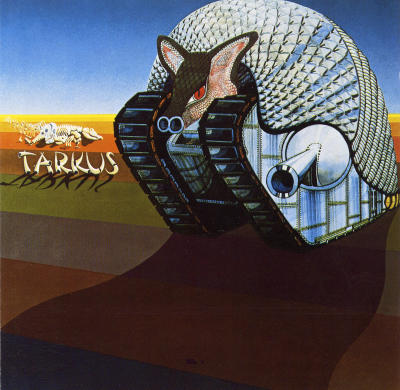- Tarkus (song)
Song_infobox
Name = Tarkus

Artist =Emerson, Lake & Palmer
Album =Tarkus
Released =June 14 ,1971 (UK)
August, 1971 (US)
track_no = 1
Recorded = January 1971, Advision Studios
Genre =Progressive rock
Length = 20:41
Writer =Keith Emerson Greg Lake
next = Jeremy Bender
next_no = 2"Tarkus" is the title track of
Emerson, Lake and Palmer 's secondalbum (Tarkus ). The enormousprogressive rock epic clocks in at 20:35. It was the longest studio song by the band until the three impressions ofKarn Evil 9 and their concert performances. The name "Tarkus" refers to thearmadillo -tank from theWilliam Neal paintings on the album cover. The song "Tarkus" itself supposedly follows the adventures of Tarkus from his birth, through a fight with amanticore , which he loses and concludes with a departure of Tarkus."Tarkus" itself is broken down into seven parts:
#"Eruption" (instrumental) — 2:43
#"Stones of Years" — 3:44
#"Iconoclast" (instrumental) — 1:15
#"Mass" — 3:11
#"Manticore" (instrumental) — 1:52
#"Battlefield" — 3:51
#"Aquatarkus" (instrumental) — 3:59The parts supposedly follow Tarkus' birth in a
volcanic eruption centuries before known history. The exact nature of Tarkus' actions are unknown, and left so by the creator,Keith Emerson . "Eruption" itself presents a musical impression of cascading eruption on the keyboards in an unusual 10/8 (4+3+3)time signature , backed byCarl Palmer on drums. This segues into "Stones of Years" the first of three vocal sections. "Iconoclast" comes next, which represents travel of tarkus, and is rapidly overpowered by guitar for "Mass." "Mass," filled with numerous religious references, often has its lyrics dropped in tours by theKeith Emerson Band , as doesStones of Years . This is followed by "Manticore" in which the enemy of Tarkus appears and a battle ensues between variations on the "Tarkus" theme and the manticore's. Ultimately Tarkus is defeated and "Battlefield" follows — the only part written entirely byGreg Lake , containing some of the deepest and most moving lyrics of the album. "Aquatarkus" closes the track, centreing mostly on a march based on the theme and then returning to the original eruption as a farewell to Tarkus.According to Emerson, while Palmer was excited by some of the technical opportunities the song would present, Lake was not quite so enamoured. However Lake evidently did have the album grow on him, stating in an interview after the release: "It's about the futility of conflict expressed in (the)context.. of soldiers and war. But it's broader than that. The words are about revolution that's gone, that has happened. Where has it got anybody? Nowhere." He has also complimented "Stones of Years" as one of his favourite parts of "Tarkus," though admits he is not entirely sure about what it means, but says it is about, "listening, understanding, hearing."
The song remains a fan favourite and was, and still is, consistently played at ELP, Keith Emerson Band and Carl Palmer band concerts.
"Stones of Years" was used as a single from "Tarkus." The album as a whole reached number 1 on UK charts and number 9 in the US.
In 2004, the Japanese classical pianist Aki Kuroda released an album with a classical adaptation of "Tarkus".
In 2007,
Dream Theater keyboardist,Jordan Rudess , included a cover of this song in his solo semi-tribute album: The Road Home.See also
*
List of works in unusual time signatures
Wikimedia Foundation. 2010.
